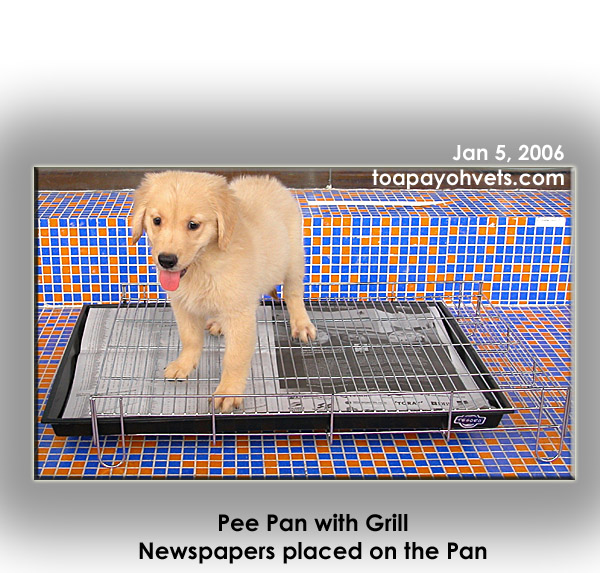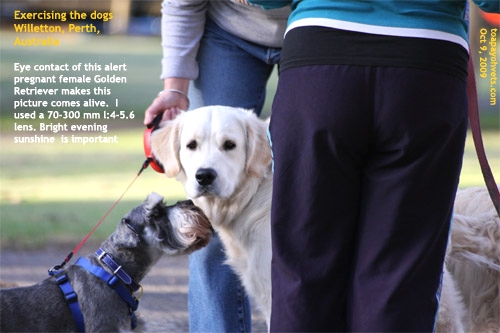472. Toilet Training 2 puppies at one time
Toilet Training Your First Puppy in Singapore
E-MAIL TO DR SING, JUL 19, 2009
On Sun, Jul 19, 2009 at 12:23 PM, <...@yahoo.com.sg> wrote:
Hi judy,
I hope this is not too much trouble for u. I recently bot 2 japanese spitz puppies. They are with me for 3 weeks now. The first 2 weeks, i admit i make some mistakes in the house breaking training.
Now i have confined the 2 puppies separately in 2 play pen. When the puppies are inside the play pen, they usually most of the time would pee n poo on the pee tray. When i open up the play pen to let them play hard, they would pee on other places. One pee very far, so i thought he prob couldnt find his way back. The other one pee abt 20 cm away from the pee tray. Why is it that when the play pen is opened up, they forgot where they shld pee just like how well behave they are when they are confined in the play pen.
Can u give me some advice as to what i shld do? I am so close to pulling out all my hair.
Thanks n regards
XXX
E-MAIL FROM DR SING, JUL 19, 2009
I am Dr Sing. Thank you for your e-mail.
1. In reply, I presume you have two puppies coming out of the 2 playpens at the same time.
2. The two are then given a much bigger area to play. They forget about their pee tray.
3. Ideally, you should permit one puppy to come out to an extended area which is around 2X the area of the playpen (e.g kitchen area). Open the playpen gate and monitor the puppy. If he goes to the pee tray, praise and give food treat. If he shows signs of wanting to pee, carry him quickly to the pee tray. Be observant.
4. The other puppy should be confined and not be seen by the other puppy while you train this one.
5. Repeat paragraph 3 with the other puppy.
6. In cases where there is only one puppy, it takes 2-4 weeks of confinement inside the playpen 90% of the time before they know that they must go to the pee tray to eliminate when they are let out of the playpen into a bigger area (not the whole apartment, just the kitchen or bathroom as an example). It is not just 1 week as that was what I presumed you did.
7. Therefore, go back to the basics as mentioned in paragraph 3.
Dear mr sing,
Thank you very much for your prompt reply. I really really appreciate it. I will listen to your advice and do as u said. I will definitely write back once the house breaking training is successful for the 2 puppies.
A big thank you.
XXX
On Wed, Jul 22, 2009 at 3:50 PM, XXX wrote:
Hi dr sing,
I need more advice. One of the puppy behave really well when she is in her play pen. She poo n pee almost 95% on the pee tray. I followed your advice n give her a bigger area in the kitchen. I have a really big kitchen so i still hv to use the play pen to make the area only 2x the area of the playpen she is staying in. But she still doesnt know how to go to the pee tray to pee. But when i bring her back to her own play pen, she almost immediately pee n poo on the pee tray!
Why is that? What hv i done wrong? N what more shld i hv done?
The other puppy is hopeless. I didnt even wanna try the 2x play pen kitchen strategy on him. I think i need to confine him for another 1 or 2 weeks b4 i try the 2x play pen kitchen strategy. What do u think?
Sorry to bother u agn.
Pls advise me on this.
Regards
XXX
E-MAIL FROM DR SING, JUL 22, 2009
Hello
1. Start from the beginning again.
2. Confine the puppies for 2 weeks inside the playpen.
3. When you increase the area to 2X the area of the playpen initially, your puppy is "distracted" by your attention and forgets to go to the pee tray.
E-MAIL TO DR SING, JUL 19, 2009
On Sun, Jul 19, 2009 at 12:23 PM, <...@yahoo.com.sg> wrote:
Hi judy,
I hope this is not too much trouble for u. I recently bot 2 japanese spitz puppies. They are with me for 3 weeks now. The first 2 weeks, i admit i make some mistakes in the house breaking training.
Now i have confined the 2 puppies separately in 2 play pen. When the puppies are inside the play pen, they usually most of the time would pee n poo on the pee tray. When i open up the play pen to let them play hard, they would pee on other places. One pee very far, so i thought he prob couldnt find his way back. The other one pee abt 20 cm away from the pee tray. Why is it that when the play pen is opened up, they forgot where they shld pee just like how well behave they are when they are confined in the play pen.
Can u give me some advice as to what i shld do? I am so close to pulling out all my hair.
Thanks n regards
XXX
E-MAIL FROM DR SING, JUL 19, 2009
I am Dr Sing. Thank you for your e-mail.
1. In reply, I presume you have two puppies coming out of the 2 playpens at the same time.
2. The two are then given a much bigger area to play. They forget about their pee tray.
3. Ideally, you should permit one puppy to come out to an extended area which is around 2X the area of the playpen (e.g kitchen area). Open the playpen gate and monitor the puppy. If he goes to the pee tray, praise and give food treat. If he shows signs of wanting to pee, carry him quickly to the pee tray. Be observant.
4. The other puppy should be confined and not be seen by the other puppy while you train this one.
5. Repeat paragraph 3 with the other puppy.
6. In cases where there is only one puppy, it takes 2-4 weeks of confinement inside the playpen 90% of the time before they know that they must go to the pee tray to eliminate when they are let out of the playpen into a bigger area (not the whole apartment, just the kitchen or bathroom as an example). It is not just 1 week as that was what I presumed you did.
7. Therefore, go back to the basics as mentioned in paragraph 3.
Dear mr sing,
Thank you very much for your prompt reply. I really really appreciate it. I will listen to your advice and do as u said. I will definitely write back once the house breaking training is successful for the 2 puppies.
A big thank you.
XXX
On Wed, Jul 22, 2009 at 3:50 PM, XXX wrote:
Hi dr sing,
I need more advice. One of the puppy behave really well when she is in her play pen. She poo n pee almost 95% on the pee tray. I followed your advice n give her a bigger area in the kitchen. I have a really big kitchen so i still hv to use the play pen to make the area only 2x the area of the playpen she is staying in. But she still doesnt know how to go to the pee tray to pee. But when i bring her back to her own play pen, she almost immediately pee n poo on the pee tray!
Why is that? What hv i done wrong? N what more shld i hv done?
The other puppy is hopeless. I didnt even wanna try the 2x play pen kitchen strategy on him. I think i need to confine him for another 1 or 2 weeks b4 i try the 2x play pen kitchen strategy. What do u think?
Sorry to bother u agn.
Pls advise me on this.
Regards
XXX
E-MAIL FROM DR SING, JUL 22, 2009
Hello
1. Start from the beginning again.
2. Confine the puppies for 2 weeks inside the playpen.
3. When you increase the area to 2X the area of the playpen initially, your puppy is "distracted" by your attention and forgets to go to the pee tray.




